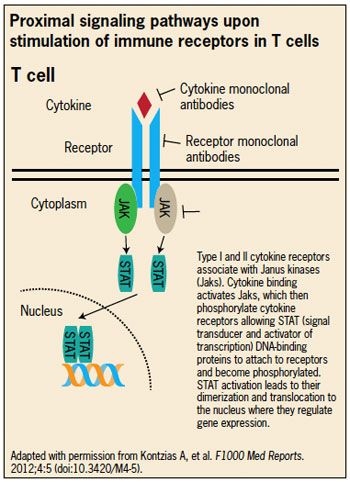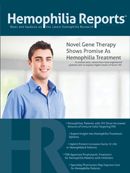Publication
Article
Hemophilia Reports
New Oral JAK Inhibitors Wait in the Wings
The Janus kinase ( JAK) molecule is an immunomodulating signal transduction agent, which has emerged as a new target for rheumatoid arthritis (RA) research.
T
he Janus kinase ( JAK) molecule is an immunomodulating signal transduction agent, which has emerged as a new target for rheumatoid arthritis (RA) research. Four JAK enzymes have been identified: JAK1, 2, 3, and TYK2.
All four enzymes are critical components of signaling mechanisms utilized by a number of cytokines and growth factors, including those that are elevated in patients with RA. Cytokines such as interleukin-6, 12, and 23 signal through the JAK pathway; these particular cytokines have already been clinically validated as therapeutic targets in inflammatory diseases.
Several agents for RA that target the JAK enzymes are now in development, including:
- Tofacitinib: inhibits JAK1, JAK2, and JAK 3
- Baricitinib: inhibits JAK1 and JAK2, and its manufacturer describes it as “JAK3-sparing”
Tofacitinib (Pfizer) Inhibits JAK1, JAK2, and JAK3: Phase III data
Tofacitinib is likely to be the first oral biologic agent to be approved in the US for treatment of patients with RA. Tofacitinib is an oral JAK inhibitor, now with phase III data under review. In the pivotal trials, both the 5-mg twice-daily dose and the 10- mg twice-daily dose of tofacitinib were superior to placebo on three primary efficacy endpoints.
However, while the FDA Advisory Board in May 2012 moved the drug forward with a highly positive 10 to 0 vote on its efficacy data, the vote on safety data was somewhat troubling at 7 positive votes, 2 negatives, and 1 abstention. The negative reviews were most affected by a perceived increased risk of malignancy in the higher-dosage arm of the trial, with one reviewer saying that it was not regarded as a class effect, but rather as a drug-related risk. Further discussion during FDA review will probably rest on whether the increased efficacy benefit between the lower and higher doses justifies the increased safety risk. The manufacturer is seeking an indication for treatment of patients with moderate-to-severe RA.
The efficacy bar was higher for secondary endpoints, with an endpoint of ACR50, a 50% improvement in symptoms. Results were fairly similar between active treatment arms, with 33.8% of patients on the 5-mg dosage and 36.6% of those on the 10-mg dosage reaching that level of recovery compared with 12.7% of patients on placebo.
Efficacy endpoints at 6 months were: Clinical improvement (ACR20): 52.7% on the 5-mg dosage; 58.3% on the 10-mg dosage. Remission: 11% on the 5-mg dosage and 14.8% on the 10-mg dosage.
Efficacy endpoints at 3 months were: Change from baseline in HAQ-DI (Health Assessment Questionnaire Disability Index): 0.46 decline in disability on the 5-mg dosage; 0.56 decline in disability on the 10-mg dosage.
In this 12-month study, patients with RA who were treated with background, nonbiologic, disease-modifying antirheumatic drugs (DMARDs) such as methotrexate were randomized to one of the tofacitinib arms for the next 6 months. At 3 months, nonresponding patients on placebo were reassigned to one of the tofacitinib arms. At 6 months, the remaining patients on placebo were put on one of the two dosages of tofacitinib.
Proximal signaling pathways upon stimulation of immune receptors in T cells
Pathways

Rollover to enlarge.
Once all patients were put on tofacitinib, the placebo patients achieved treatment responses similar to other tofacitinib patients, and all were able to maintain improvements through 12 months.
Source:
Kremer J, Li Z-G, Hall S, et al. Tofacitinib (CP-690,550), an oral JAK inhibitor, in combination with traditional DMARDS: phase 3 study in patients with active rheumatoid arthritis with inadequate response to DMARDS. Ann Rheum Dis. 2011;70(suppl 3):170.
Baricitinib (Lilly and Company/Incyte) Inhibits JAK1 and JAK2: Phase IIb Data
A second oral JAK inhibitor for RA is not far behind tofacitinib. Researchers announced promising results for baricitinib from a phase IIb study at the European League Against Rheumatism (EULAR) Congress in June 2012, only a month after tofacitinib was moved forward by the FDA Advisory Committee. Trial results showed significant efficacy in patients with active RA. Baricitinab was administered in a combination regimen with methotrexate.
A placebo-controlled, dose-ranging study showed statistically significant differences in achieving the ACR20 score between placebo (41%) and the two highest-dose baricitinib groups (76%) at 12 weeks. A significant difference was also observed at the earliest assessment point, after 2 weeks of treatment, and was sustained to 12 weeks.
This was a small study of 301 patients with active RA who were on stable doses of methotrexate. Patients were randomized to receive placebo or one of four once-daily doses of baricitinib (1 mg, 2 mg, 4 mg, or 8 mg). Baricitinib is also being tested in phase II trials in patients with psoriasis.
Source:
Keystone E, Taylor P, Genovese M, et al. 12-week results of a phase 2B dose-ranging study of LY3009103 (INCB028050), an oral JAK1/JAK2 inhibitor, in combination with traditional DMARDs in patients with rheumatoid arthritis. Ann Rheum Dis. 2012;71(suppl 3):152.
